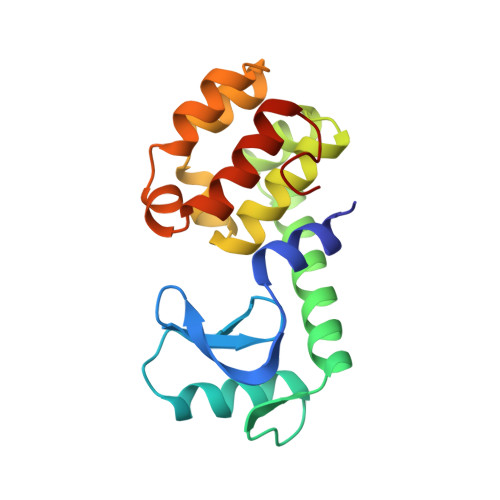Multiple alanine replacements within alpha-helix 126-134 of T4 lysozyme have independent, additive effects on both structure and stability.
Zhang, X.J., Baase, W.A., Matthews, B.W.(1992) Protein Sci 1: 761-776
- PubMed: 1304917
- DOI: https://doi.org/10.1002/pro.5560010608
- Primary Citation of Related Structures:
1L69, 1L70, 1L71, 1L72, 1L73, 1L74, 1L75 - PubMed Abstract:
In a systematic attempt to identify residues important in the folding and stability of T4 lysozyme, five amino acids within alpha-helix 126-134 were substituted by alanine, either singly or in selected combinations. Together with three alanines already present in the wild-type structure this provided a set of mutant proteins with up to eight alanines in sequence. All the variants behaved normally, suggesting that the majority of residues in the alpha-helix are nonessential for the folding of T4 lysozyme. Of the five individual alanine substitutions it is inferred that four result in slightly increased protein stability and one, the replacement of a buried leucine with alanine, substantially decreased stability. The results support the idea that alanine is a residue of high helix propensity. The change in protein stability observed for each of the multiple mutants is approximately equal to the sum of the energies associated with each of the constituent substitutions. All of the variants could be crystallized isomorphously with wild-type lysozyme, and, with one trivial exception, their structures were determined at high resolution. Substitution of the largely solvent-exposed residues Asp 127, Glu 128, and Val 131 with alanine caused essentially no change in structure except at the immediate site of replacement. Substitutions of the partially buried Asn 132 and the buried Leu 133 with alanine were associated with modest (< or = 0.4 A) structural adjustments. The structural changes seen in the multiple mutants were essentially a combination of those seen in the constituent single replacements. The different replacements therefore act essentially independently not only so far as changes in energy are concerned but also in their effect on structure. The destabilizing replacement Leu 133-->Ala made alpha-helix 126-134 somewhat less regular. Incorporation of additional alanine replacements tended to make the helix more uniform. For the penta-alanine variant a distinct change occurred in a crystal-packing contact, and the "hinge-bending angle" between the amino- and carboxy-terminal domains changed by 3.6 degrees. This tends to confirm that such hinge-bending in T4 lysozyme is a low-energy conformational change.
- Institute of Molecular Biology, Howard Hughes Medical Institute, University of Oregon, Eugene 97403.
Organizational Affiliation:


















